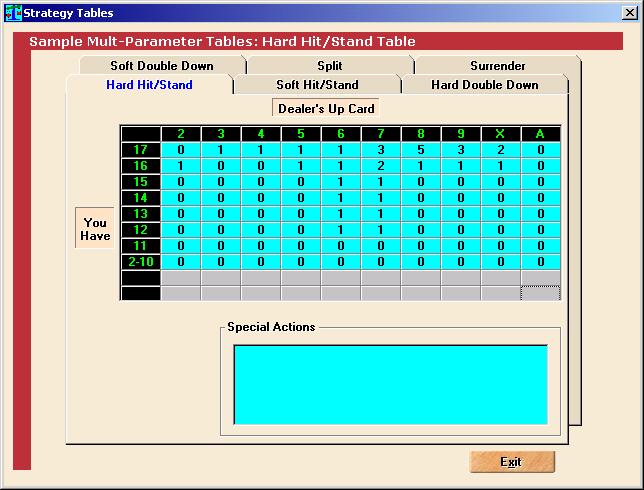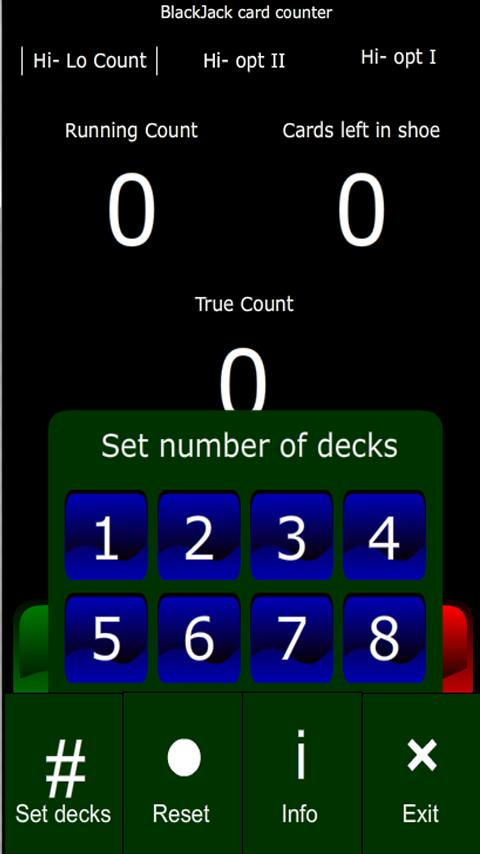Hi Opt
US Players and Credit Card, BitCoin Deposits Accepted!
High Opt 1 Card Counting System
The Hi-Opt I (Hi Opt 1) blackjack card counting system, a version of Hi-Opt (highly optimum) counting systems, is a card counting strategy that is designed for use by more advanced blackjack players. This system works similiar to the the Hi-Lo card counting system but has a few additional rules and card value changes which make the count more accurate. The Hi-Opt I system is also often referred to as the Einstein Count.
The Hi-Opt 2 Card Counting System – Rules Being a balanced system you’ll start your ‘running count’ with the first card that is dealt from the shoe (whether the shoe has just a single deck or more than one). You’ll now add or subtract values to and from the running count based on the following cards. The Hi-Opt II card counting system is a strategy for overcoming the house edge in sustained games of Blackjack. It’s not a method (nor could any system be) for automatically winning every hand that you play – you can still expect to consistently lose a number of hands as you prospect the deck.
Hi-Opt II – A more complex, Level 2, balanced strategy developed by Lance Humble and Julian Braun. Found to be more powerful than even some Level 3 card counting strategies. (See Blackjack Attack.) Hi-Opt II can be found in the proprietary HiOpt II Report. The Hi-Opt 1 Counting system is designed for those who are ready to use more complicated and advanced counting methods. As with all the other complicated gambling strategies, this one is debatable and there are those who believe in it and use it and there are those who think it does not work because they've lost once or twice. Hi Opt 2 Card Counting System for Blackjack The Hi-Opt II method of card counting takes the Hi-Opt I as a foundation but introduces new point values in an effort to increase the accuracy and efficiency of the count. You should understand right from the beginning that the Hi-Opt II system is more complex than most counting methods.
If you are wanting to become a serious blackjack player, you should definitely consider using the Hi-Opt I card counting system. This system is more mathematically advanced and can provide a slightly larger edge for the player, compared to previous card counting systems. There are blackjack players that claim this small extra percentage of player advantage isn't enough to justify using a more complicated system, but some players disagree and feel that the Hi-Opt I strategy is a far superior counting method.
Hi-Opt I Card Counting Strategy Explained
The Hi-Opt I count isn't overly complicated but it does take more focus at the table. This system is also based on adding and subtracting the number 1, so only simple math is used. To use this card counting system you'll need to learn the respective value for each card in a deck. Make sure you review this chart several times to avoid confusing the values with those of other counting systems.
3 | 5 | 7 | 9 | J | K | |
0 | +1 | +1 | 0 | -1 | -1 | 0 |
As you can see, there are seperate groups of card values. All 2's in the deck carry a value of 0 in this system and don't change the count when they are played. The 16 other small cards (3-6) are counted as plus 1 as they are played. The 12 middle cards (7-9) are considered neutral cards and do not change the count as they are played. The 16 big cards (10-King), excluding Aces, are counted as minus 1 as they are played.
There are separate rule variations for tracking Aces in the Hi-Opt I counting system. This system doesn't keep track of Aces in the card count but there are still changes to basic strategy that need to be made depending on how many aces have been played. Many players use external things such as chips, fingers, or feet, to keep track of how many aces have been played. Ken Uston recommended using your feet in his book Million Dollar Blackjack. We will not cover ace variations in this section.
More Card Counting Systems:
See also:
Follow-up: I guess this would apply to Hi-Opt 2 as well if I ever get confident enough to learn it.

I'm not a Hi-Opt specialist, but I wanted to get your thread rolling and hopefully one of the other Hi-Opt users will respond. You say on other sites you've read for Hi-Opt 1 you should stand on 16 v 10 at +1 or +2... Well which was it? Could you link those sites? If the sites appear to have some merit to them, and explain why, then I would think to believe them. As a hi/low player I can tell you the reason basic strategy says to hit 16 v 10 is because there's no combination of 16 v 10 you can make off the top of a deal that doesn't involve a negative count. It's always -1 (even for hi-opt 1). Thus, for it to be even, or positive, when you find yourself in the situation of 16 v 10 there absolutely has got to be at least 1 or 2 more 'small cards' removed than big cards. With this knowledge alone (and the fact that 16 vs 10 is such a close play off the top) I would think the correct play from Basic Strategy is to stay, regardless if you're using Hi/Low or Hi-Opt 1.
In his training courses Semyon Dukach even states this is such a close decision that if you're torn (i.e. in your position) one could even use the current cards on the table as a reference whether to hit or not. He stated if there are any 5's on the table to stay, otherwise take the hit. Again, this is presuming you're at a point where Hi/Low TC = 0 and Hi-Opt 1 TC = +1... in which you're saying you're not sure what to do.
Hopefully someone whom specializes in Hi-Opt 1 can chime in, but for my 2 cents I would stay in a TC >= 0, even with Hi-Opt 1 (which is a very similar count to Hi/Low anyways).
Would you not surrender 16 v 10 if at all possible first? I am guessing we are assuming the casino doesn't offer surrender?
Yes, we are assuming the casino doesn't offer surrender or you have more than 2 cards. But yes always surrender 16 v 10 unless you know the correct index
So my suggestion is to just go with Hi Lo since the information is easier to find. Unless you are following along with a very good tutorial that uses Hi Opt I, you can stick to learning that count (but if this tutorial is really that good, you wouldn't be having doubts about the index for 16v10). Both counts will get you the money (so long as you use them correctly)

Wong's book says surrender at TC >= +1
However it also says to split at TC <= +8 ( H17, DAS )
Obviously these indicies overlap, I take it that the surrendering index should take priority, especially at the higher TCs? The game I am specifically using this for is
6D, H17, DAS, Late Surrender, Dealer Peek, RAS 4x, Double Any Two.
Similarly for 8,8 vs A
TC >= -1 Split
TC < +4 Surrender
So Surrender at TC < +4, Split at TC >= +4?
Thanks for any help.

Surrender before splitting, standing, hitting
This.... Surrender.

Hi Opt 2
Hi Optel
which indicates to stand on +2 for 16 v 10. The text file looks like it's from a pretty old article, but the basic strategy listed on it looks right to me except for a couple instances.
I'm not sure how trustworthy this document is. I initially thought it said to stand on +1 for 16 v 10 but now that I look at it again, it says +0, like for Hi-Lo. I must have remembered the footnote instead of the actual index number (oops!)
The only reason I would think to stand on a higher count is because Aces and 2's in the deck would keep you from busting, but they're not being counted in Hi Opt 1...
I want to use Hi-Opt 1 with a side count of Aces since Hi-Opt 1 supposedly has a higher PE than Hi-Lo, and the Ace side count should make up for the loss of BC for switching to Hi-Opt 1. That does make me wonder how accurate the reports on higher PE would be if the indices aren't really that accessible.
The casino closest to me has Single Deck, No Surrender, No DAS, Double any 1st two cards, H17. Since it's Single Deck, I thought PE would be pretty important.
The two links that I found on Hi Opt 1 indices:
http://www.textfiles.com/fun/hi-opt-1.txt
which indicates to stand on +2 for 16 v 10. The text file looks like it's from a pretty old article, but the basic strategy listed on it looks right to me except for a couple instances.
http://www.onagerware.com/images/Hi-Opt_I_1_or_2_decks_with_no_DAS_no_Surrender_dbl_any_2_cards_DHit_S-17.pdf
I'm not sure how trustworthy this document is. I initially thought it said to stand on +1 for 16 v 10 but now that I look at it again, it says +0, like for Hi-Lo. I must have remembered the footnote instead of the actual index number (oops!)
The only reason I would think to stand on a higher count is because Aces and 2's in the deck would keep you from busting, but they're not being counted in Hi Opt 1...
I want to use Hi-Opt 1 with a side count of Aces since Hi-Opt 1 supposedly has a higher PE than Hi-Lo, and the Ace side count should make up for the loss of BC for switching to Hi-Opt 1. That does make me wonder how accurate the reports on higher PE would be if the indices aren't really that accessible.
The casino closest to me has Single Deck, No Surrender, No DAS, Double any 1st two cards, H17. Since it's Single Deck, I thought PE would be pretty important.
You should invest in the software at qfit.com. It will give you the indices that you are looking for. Additionally, it will give you what kind of bet spread you should use, risk of ruin, expected value, etc.
Hi Optifine Cape
- Page 1 of 2